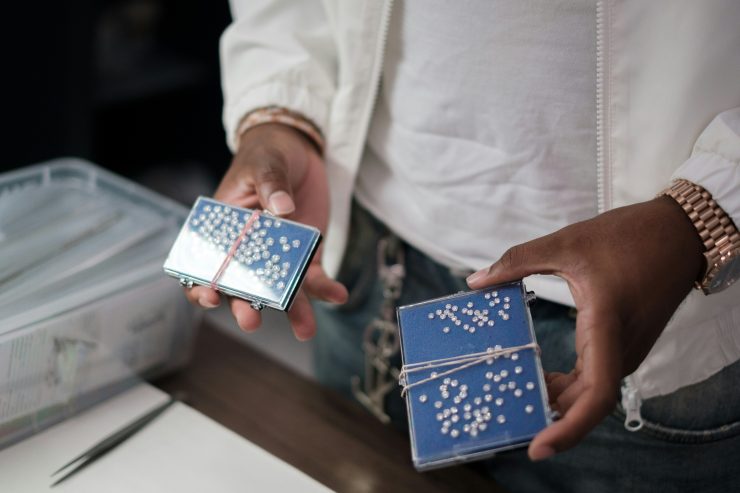Before entering any negotiation, it is essential to understand the true market value of your diamonds. This involves more than simply looking at the carat weight or clarity; you need a comprehensive picture that includes the cut, color, certification (such as GIA or IGI), and current demand trends. Market prices for diamonds fluctuate based on global demand, geopolitical factors, and shifts in luxury consumer behavior. Tools like the Rapaport Price List can offer guidance on wholesale pricing, but sellers should understand that this list serves as a general benchmark rather than a definitive price tag. Additionally, it’s important to differentiate between wholesale and retail values. A diamond appraised for insurance purposes may carry a value that is not realistically attainable in the resale market. Consulting with multiple appraisers or gemologists may give you a more balanced view. Having detailed documentation, including grading reports and purchase receipts, helps to strengthen your negotiation position by offering verifiable proof of quality and authenticity.

Researching the Buyer Before Negotiation
The next critical step in the negotiation process is thoroughly researching the potential buyer. Whether you are selling to a private individual, a pawnshop, a jeweler, or an online diamond buying platform, each type of buyer will have different motivations and pricing models. A private buyer might pay closer to retail value if they are emotionally motivated, such as for an engagement ring, whereas a wholesaler will likely offer below-market rates due to resale considerations. Reading online reviews, checking with the Better Business Bureau (BBB), and investigating their reputation through professional associations can reveal a lot about a buyer’s credibility and ethical practices. Transparency, security protocols for in-person meetings or shipments, and clearly stated payment policies are all important indicators of a trustworthy buyer. Sellers should prioritize working with buyers who are open to questions and are willing to explain their pricing methodology. The more information you have about your buyer’s business model, history, and market behavior, the better equipped you are to negotiate from a position of knowledge and strength.
Knowing Your Negotiation Power
Sellers often underestimate their own power in negotiations. In the diamond resale market, the seller’s leverage comes from the uniqueness and desirability of the stone, the level of documentation available, and their preparedness. If you are aware that your diamond possesses a rare combination of features — for instance, a high-clarity stone in a less common fancy color — you hold a unique asset that can command a premium. Similarly, diamonds that come with certificates from well-respected grading labs such as GIA or AGS carry more weight during negotiations. Preparedness also plays a key role. If you walk into a negotiation with a clear understanding of your bottom line and the flexibility above it, you are less likely to be manipulated by pressure tactics. Moreover, if you’ve gathered competing offers from multiple buyers, you’re in a stronger position to demand better terms. Sellers should never rush a deal simply out of urgency, especially when dealing with high-value assets like diamonds. Knowing when to walk away is sometimes the most powerful move in a negotiation.
Setting Realistic Expectations
It’s important to enter negotiations with realistic expectations regarding what your diamond is worth on the secondary market. While sentimental value or an insurance appraisal might influence your perception, these figures rarely align with what a buyer is willing to pay. The resale market is generally less lucrative for sellers compared to the initial retail market, especially for mass-produced or lower-clarity stones. This reality doesn’t mean you should accept lowball offers, but it does mean understanding the constraints within which buyers operate. Jewelers and dealers need to resell the stone at a profit, often after re-cutting, re-setting, or re-certifying the piece, which impacts what they are willing to offer. Educated sellers can make more informed decisions by comparing multiple offers, understanding resale margins, and preparing for counter-offers. Additionally, sellers should take into account the liquidity of their diamond — for instance, round brilliant cuts typically sell faster than fancy cuts — which can impact how much negotiation room is available. Clear-headed realism, rather than emotional attachment, should guide your pricing strategy.
Presenting Your Diamond in the Best Possible Light
First impressions can significantly influence the negotiation process, and this holds true even when selling a diamond. Presenting your stone in the best possible condition can improve its perceived value. Before showing your diamond to any prospective buyer, ensure it is professionally cleaned and polished. Even the most brilliant cut can look dull if clouded by skin oils, dust, or grime, and this can subconsciously lower the buyer’s perceived value. A high-quality presentation also includes proper documentation, such as lab certificates, appraisals, and any original packaging. Presenting a complete story around your diamond — including provenance, unique features, or any history that enhances its value — can help make it stand out in the buyer’s mind. Photographs and videos may also be useful if selling online, but these should be taken in proper lighting to avoid misrepresentation. A well-prepared seller who communicates the value and uniqueness of the diamond clearly and confidently tends to have an upper hand during the negotiation process.

Timing Your Sale Strategically
Timing can play a major role in how much you can get for your diamond. The demand for diamonds fluctuates throughout the year, with certain periods — such as the weeks leading up to Valentine’s Day, Christmas, and engagement season (typically late fall) — seeing increased buyer interest. Selling during these high-demand periods can increase your chances of securing a better offer. Additionally, macroeconomic factors such as inflation, changes in consumer spending habits, or shifts in gold and diamond prices can influence buyer behavior. Sellers should also consider timing from the perspective of buyer availability. For instance, jewelers may be more aggressive with offers during inventory restocking periods, while online platforms may have promotional pricing windows. Following industry news, diamond market reports, and auction trends can provide helpful clues as to when selling might be most profitable. Although it’s not always possible to time a sale perfectly — especially if you need liquidity quickly — being aware of timing dynamics can help you avoid undervaluing your diamond in a slow market.
Mastering the Art of Communication
Effective communication is a cornerstone of successful negotiation, especially in high-value transactions like diamond sales. Sellers should approach discussions with clarity, confidence, and professionalism. Avoid overhyping your diamond or making unsupported claims, as savvy buyers may view this as a red flag. Instead, speak factually, using documentation and objective quality indicators to justify your asking price. It’s also helpful to adopt a calm and patient tone, allowing space for the buyer to respond without feeling pressured. Active listening is equally important: understand what the buyer is looking for, how they appraise value, and what factors might cause hesitation. If you’re able to address those concerns constructively, you increase the likelihood of a mutually beneficial outcome. Be ready to make concessions if needed, but always attach conditions or counterbalances to these concessions (e.g., quicker payment in exchange for a slight discount). Ultimately, your goal should be to build rapport while maintaining firm control over the value narrative surrounding your diamond.
Using Competitive Offers to Your Advantage
One of the most effective strategies in diamond negotiations is leveraging multiple offers. By gathering written or verbal offers from several buyers — whether from local jewelers, pawnshops, or online platforms — you gain comparative insight into the range of prices your diamond can command. This not only helps you assess fairness but also serves as a powerful negotiation tool. If Buyer A offers you $3,500 and Buyer B offers $4,200, you can use the higher offer to either negotiate upward with Buyer A or solidify your confidence in accepting Buyer B’s proposal. Some buyers may even have a “price match” or “best offer” policy, which you can use to your advantage. Keep in mind that the quality of the offer includes more than just price — the payment method, transaction speed, and service reputation all matter. Presenting competitive offers should be done tactfully, without appearing manipulative. Phrase your communication in a way that emphasizes your intent to secure a fair deal, rather than pitting buyers against each other.
Understanding Buyer Tactics and Staying Grounded
In many cases, buyers — especially those who deal in high volumes — use certain psychological tactics to push prices downward. Common methods include pointing out minor flaws, questioning certificate validity, or creating artificial urgency (“I have another customer interested in the same stone”). While some of these tactics may have a basis in fact, others are designed to introduce doubt and pressure the seller into accepting a lower price. Being prepared for these strategies helps you remain grounded and confident during negotiation. Responding with facts, documentation, and calm assertiveness can defuse many of these tactics. It’s also helpful to bring a third-party perspective into the conversation, such as a second opinion from an independent appraiser. Sellers should never feel rushed into a decision and must remember that walking away is always an option. Maintaining emotional detachment, particularly when selling heirloom or sentimental pieces, ensures that decisions are based on market value rather than personal attachment.
Finalizing the Deal Securely and Professionally
Once a price has been agreed upon, the final step is to ensure that the transaction is completed securely. If you are selling in person, meet in a safe, public location — ideally at a jewelry store or with security present — to complete the exchange. For online transactions, always use insured shipping with tracking, and ensure that the buyer has a transparent process for evaluating and confirming the stone upon receipt. Avoid accepting personal checks or unsecured payment methods; instead, opt for bank wires, certified checks, or trusted payment platforms. Document the entire agreement in writing, especially for high-value diamonds, and include details such as the price, payment terms, condition of the stone, and any return policies. Reputable buyers will typically provide a formal sales agreement or invoice — if they don’t, consider it a red flag. Once payment has cleared and all documentation is in place, only then should you consider the transaction fully complete. Taking these precautions protects both your asset and your financial outcome.